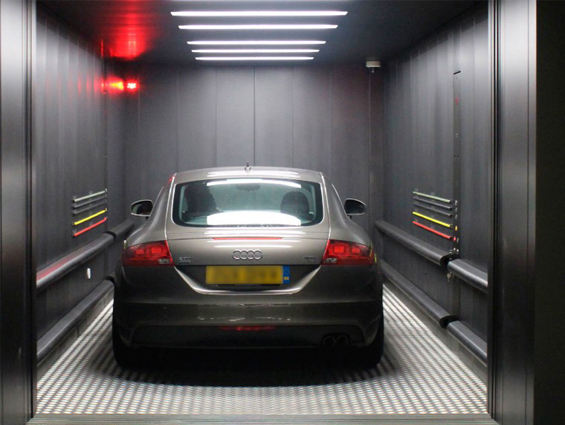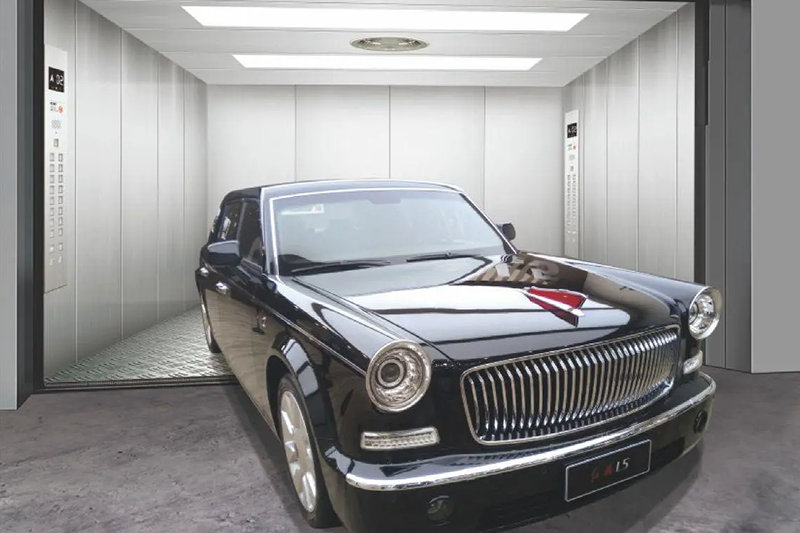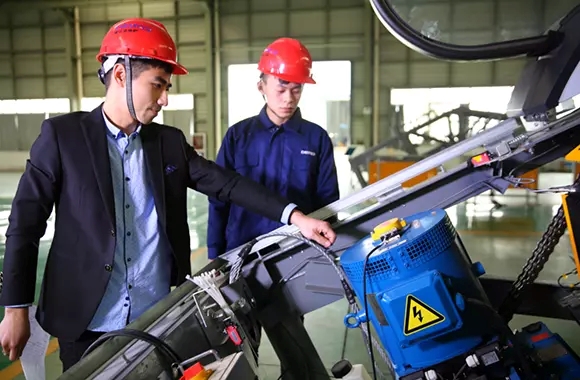In a world where finding parking is tough, car elevators, or car lifts, provide a smart solution. These systems move cars between different levels of a building. This helps save space and adds a nice touch of luxury to any structure. Whether for a home, a business, or a car dealership, a car elevator can be made to fit the specific needs of the building. You can adjust the platform size and choose the type of elevator technology that works best.
A car elevator, which is also known as a vehicle elevator or automobile elevator, is a smart mechanical device. It moves cars up and down between different levels of a building. Unlike regular ramps that take up a lot of space, car elevators save space by going vertical. This makes them great for busy city areas and places with little parking space.
This kind of elevator system includes a big platform for the vehicle, a hoisting device, and guide rails to help it move smoothly up and down. You can often find car elevators in many places, like homes, commercial parking garages, and car dealerships.

There are mainly two types of car elevators: hydraulic and traction. Each type works differently and has its own benefits. Knowing these differences can help you choose the right car elevator for your needs.
Hydraulic elevators are great for low-rise buildings. They are strong and operate smoothly. On the other hand, traction elevators use cables and counterweights to lift the car. This makes them perfect for high-rise buildings because they are faster and more efficient.
Hydraulic car lifts are a common choice for low-rise buildings, generally up to five or six floors. These elevators lift the car using hydraulic power. A piston moves up and down using pressurized fluid to raise and lower the platform. This simple method makes sure they work well and need less maintenance than other types.
One big advantage of hydraulic car lifts is their flexibility. They can be installed in different sizes, so they fit well in both small residential garages and larger commercial parking areas. Plus, hydraulic systems operate smoothly, giving a nice ride for both vehicles and people.
The strong construction and easy design of hydraulic car lifts help them last longer and perform better over time. However, they only work for low-rise buildings, so they are not suitable for high-rise structures.
Traction elevators are different from hydraulic car elevators. They use cables and counterweights to lift and lower the car. This design makes them faster and able to go further. Because of this, they are the best option for tall buildings and places with many levels. Their efficient use of space and speed makes traction car elevators perfect for commercial parking garages and big residential buildings.
These elevators are generally quieter than hydraulic ones. This gives users a better experience. Many traction elevators also have advanced features, like systems that help control where passengers go and technologies that save energy. This is why they are becoming more popular in new buildings.
Installing traction elevators is more complicated. They need a special machine room for the control systems and the motor. Despite this, their high performance, efficiency, and advanced features make them a good investment for large projects.
When planning, figuring out the car elevator price is important. The cost of a car elevator can change. It depends on various factors like the type of elevator, its size, and weight capacity. Installation needs and customization options can also affect the price.
A basic car elevator might look affordable at first. However, you should also consider other expenses. This includes installation costs, permits, and any changes needed in the building. To get a clear and accurate quote for your project, consulting with a good car elevator company is very important.

The cost of a car elevator can change based on several things. It is not the same for everyone. This price depends on specific needs, what the building requires, and personal preferences. All of these factors will directly impact the final budget.
One major reason for the cost is the type of car elevator. Hydraulic car elevators are usually cheaper for low buildings. In contrast, traction elevators are needed for taller buildings and are more expensive. The size and weight capacity also matter a lot. Larger platforms and bigger weight limits need stronger materials and parts, which increases the cost.
Another big part of the total cost is what it takes to install the elevator. Site accessibility, what is already there, and extra construction can all affect the installation process and its costs. Plus, custom options such as finishes, door styles, and safety features can also change the final price.
While determining an exact car elevator price without considering specific project requirements is impossible, providing a general range of prices can offer some initial insight into the potential costs. This range can serve as a starting point for budgeting purposes, keeping in mind that various factors can influence the final price.
Basic hydraulic car elevators with standard features and lower weight capacities may range from $20,000 to $40,000. In contrast, more advanced traction car elevators, often utilized in high-rise buildings and featuring higher weight capacities, can cost upwards of $50,000 and even exceed $100,000 depending on complexity.
Here's a simple table summarizing the general car elevator price range:
Car Elevator Type | Price Range (USD) |
|---|---|
Small Hydraulic Car Elevator (2,000-3,000kg) | $30,000 - $50,000 |
Mid-Size Hydraulic Car Elevator (3,000-4,000kg) | $50,000 - $80,000 |
Large Traction Car Elevator (5,000kg+) | $80,000 - $150,000 |
Custom High-Rise Car Elevator | $100,000 - $300,000+ |
When you decide to add a car elevator to your building, it is important to think about the size of the elevator. This way, it can safely carry different types of vehicles. There are standard sizes for many common vehicles, but you can often customize the size to fit special needs and make good use of space.
Things to consider include the size of the parking spots, how much room vehicles need to turn, and any accessibility requirements. It is a good idea to talk to a car elevator expert. They can help you find the best size of the elevator for your project. They will look at your needs, check the space you have, and assist you with choices if necessary.
Most car elevators come in standard sizes, but you can customize if needed. These standard sizes fit most passenger cars easily. Knowing these dimensions is important when planning your parking space.
The platform size is the most important thing to think about. Standard car elevator platform sizes usually start from about 8 feet wide and 18 feet deep. This size gives enough room for a typical car. You also need to think about extra space for opening doors, loading and unloading, and any larger vehicles you might need in the future.
Capacity (kg) | Platform Size (mm) | Shaft Size (mm) | Door Width (mm) |
|---|---|---|---|
2000 kg | 2500x5500 | 3200x6000 | 2500 |
3000 kg | 2800x6000 | 3500x6500 | 2800 |
4000 kg | 3000x6500 | 3700x7000 | 3000 |
5000 kg+ | Customizable | Customizable | Customizable |
Standard car elevator sizes fit many cars and building styles. However, you can customize them for special needs and better function. Custom options include changing the platform sizes, weight capacities, and adding unique designs and finishes.
A common reason to customize is to fit larger vehicles like SUVs, trucks, or vans. By making the platform longer and wider, these vehicles can be easily moved. Customizing the weight capacity helps ensure the elevator supports heavier loads safely.
You can also customize the elevator’s design and how it works. For example, different door options can help manage traffic and access at different levels of a building. Materials, finishes, and lighting can be adjusted to match the building's look or the owner's tastes, making sure everything blends well and looks good.
Before you install a car elevator, it's important to know its weight capacity. The capacity of a car elevator tells you the maximum weight it can safely lift. Picking the right load rating helps your elevator last longer and keeps both vehicles and passengers safe.
Selecting the right car elevator capacity ensures safe and efficient vehicle transport. Delfar provides car lifts with weight capacities ranging from 2,000kg to 10,000kg or more.
2,000-3,000kg – Standard sedans, compact cars.
3,000-4,000kg – SUVs, small trucks.
4,000-5,000kg – Luxury vehicles, large SUVs, service vehicles.
5,000kg+ – Industrial transport, heavy-duty vehicle lifts.

Car elevators are versatile systems with various practical applications, primarily in parking lots of commercial buildings where space optimization is crucial. These elevators efficiently move vehicles between different levels of a building, enhancing parking capacity and convenience. In addition to parking garages, car elevators are commonly used in car showrooms, automobile repair centers, and locations with specific needs for parking solutions. The adaptability of car elevators allows them to cater to the diverse requirements of different industries, making them a popular choice for establishments aiming to make efficient use of space. The flexibility and advanced features of car elevators have made them indispensable in modern infrastructure development.
In busy cities where space is limited and parking is always sought after, commercial parking garages are looking more at car elevators. These elevators help increase parking capacity without needing more ground space. By using vertical areas well, they can hold more cars without the high costs of buying more land.
Car elevators can quickly move cars up and down different levels of the garage. This cuts down congestion and helps drivers find free spots faster. They work automatically, giving drivers a smooth experience that makes them happier.
Also, adding car elevators to parking garages can create new and smart building designs. This helps use land better and fits nicely into the city environment. This is especially key in places where every bit of space counts.
As more people move into cities, living in smaller spaces is becoming normal. Car elevators are now a popular choice in new apartments. They connect parking areas, either underground or on the ground, directly to the homes above. This makes life easier for residents. It also keeps their vehicles safe.
Car elevators are not just for fancy houses anymore. They are a smart way to make the most of parking space in residential buildings. This is especially true where regular parking garages don't work. Car elevators remove the need for long ramps or tight driveways. This gives more room for other things like parks or shared areas.
Also, these elevators help residents who might have trouble climbing stairs or using ramps. This means easy access to their cars, making everyday life more comfortable. Homeowners now like this feature more and more. It suits their desire for comfort, easier living, and a bit of style in their homes.
Car dealerships and showrooms are finding new ways to display their cars and use space wisely with car elevators, also called automobile elevators. These handy systems move vehicles between different floors, giving dealerships more space to show their cars and create exciting presentations.
Picture a shiny sports car driving up from the basement right into the showroom. It would catch the attention of potential buyers. This exciting way of showing cars not only makes the place look good but also helps dealerships show more models without making it feel cramped or messy.
Also, automobile elevators offer safe and easy access to upper storage areas. They help keep valuable cars safe from damage or theft. Adding these elevators to a dealership's design can help create a more modern and attractive experience for customers.

Car elevators are now being adapted for use in car repair and service centers. These elevators, which often work like freight elevators, are very useful. They can easily lift and move heavy goods like engines, transmissions, or even whole vehicles between different levels of the service facility.
This system helps to make work easier. It cuts down on heavy lifting by hand and boosts overall efficiency. For example, a car elevator can carry a vehicle needing repair up to the right service level. This helps avoid slowdowns and makes better use of the floor space.
Also, moving heavy components safely and quickly lowers the chances of injuries to employees. It also protects expensive equipment from harm. As service centers work to be more productive and safe, car elevators are becoming important tools.
A car elevator can be very helpful and save space. However, it’s important to know that getting one installed can be complicated. It needs expert help and good planning. The process usually has a few steps. These steps include preparing the site, building the elevator shaft, installing the lifting mechanism, and adding safety features.
The installation of a car elevator is a complex task. It needs careful planning, special knowledge, and strict safety rules. Before starting, a detailed site check is important. This check looks at things like soil conditions, structural support, and available space.
After the site assessment is done, the work on the elevator shaft can start. This includes digging the pit, building the walls, putting in the guide rails, and making sure everything is level and aligned. The exact steps will depend on the type of car elevator, the building structure, and if it is a new setup or an upgrade.
When the shaft is ready, the installation of the lifting mechanism comes next. This part involves placing the motor, connecting cables or hydraulic systems, and setting up the car platform. Finally, the process ends with adding important safety features. This includes emergency brakes, door interlocks, and communication systems. All these steps help keep both the vehicle and its passengers safe.

When choosing a car elevator, it is important to think about whether to use a traditional pit-style system or a new pitless design. Pit depth is the depth dug out underneath the elevator. This can affect installation costs and how easy it is to install.
Traditional pit-style car elevators need a deep pit for the hydraulic piston or counterweights. This can be hard or even impossible in some buildings or places with high water tables. In contrast, pitless elevators have self-supporting structures. They do not need deep pits, making them a good choice in areas where pit depth is a problem.
Pitless car elevators use space well, which makes them great for retrofits or tough site conditions. However, keep in mind that while pitless systems are better for space and easy to install, they might be a bit more expensive than traditional ones.
Investing in a car elevator is an important choice. To keep it working well over time, you need to focus on regular maintenance. Car elevators, like any machine, can wear out. They need to be checked and adjusted from time to time. Sometimes, parts may need to be replaced to keep everything running safely.
Regular maintenance helps your elevator last longer. It also helps prevent unexpected breakdowns and expensive repairs. During maintenance visits, skilled technicians look at the safety features. They also lubricate moving parts and check the hydraulic fluid levels or cable tension. Plus, they fix any small issues before they become bigger problems. Following a maintenance schedule gives you peace of mind. You can be sure your car elevator is in great shape and your investment is safe.
For those looking for a mix of new ideas, reliability, and great performance, Delfar car elevators are the best choice. With many years in the business, Delfar has consistently made high-quality car elevators that go beyond what you expect. We focus on good craftsmanship, new technology, and making our customers happy. This is clear in every product we create.
Delfar car elevators come with advanced features. This ensures smooth, quiet, and safe operation while making the most of your space. We provide various customization options. This allows you to design a car elevator that fits your specific needs and matches your architectural style. Choose Delfar to enjoy a car elevator made to last, delivering superior performance and boosting the value of your property.

Investing in a car elevator can revolutionize vertical transportation, especially in commercial settings with limited parking space. The advanced features and efficient use of space make car elevators a practical choice for parking lots, showrooms, and repair centers. When considering the cost, factors such as the elevator type, size, and capacity play a crucial role. Regular maintenance is key to ensuring the long-term performance and safety of the elevator. Delfar car elevators stand out for their reliability and cutting-edge technology in the elevator industry. By selecting the right car elevator based on your specific needs, you can enhance convenience, save space, and streamline operations efficiently. Elevate your parking experience with a well-chosen car elevator.
The space required for a car elevator depends on the size of the platform and the parking areas. Usually, a car elevator needs an area that is a bit bigger than the vehicle's size. You also need extra room for safe and efficient use of space.
Yes, existing buildings can have a car elevator added. There are many options to customize this. New designs, like pitless systems, address the unique challenges of fitting car elevators into current buildings. They make good use of the space that is available and meet specific needs.